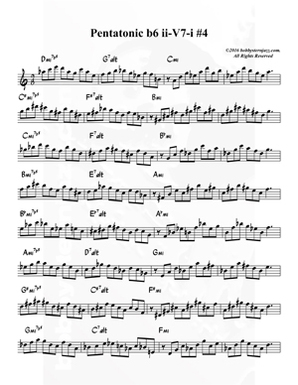A Cool Tonic for Your PentaUp b6

It's not supposed to be some sort of "snake oil" remedy you can sip on or chug down (although that could be hip), or some magic potion you could pour in your ear, so you might be able to "hear the music before it comes", a la Eddie Harris (which would be even hipper).
What it is, in fact, is another way of hearing and approaching a common 4 bar minor ii-V7-i cadence, using 3 Melodic Minor derived Pentatonic b6s, employing the "ACE" method, as described in a recent post.
All things considered, it's tried and true pretty hip, too!
 A melodic minor (she's only 17)
A melodic minor (she's only 17) However, it's not really intentional. It just happens that I often hit upon certain ideas and relationships while in the shed that both sound fresh (to my ears, anyway) as well as pique my curiosity from an intellectual and theoretical standpoint. In any case, this Penta b6 exercise is a result of that, and it makes as good a subject for another blog post as anything else I can think of at the moment.
So here goes.
The first thing you might notice about each 4 measure line is the time signature, 9/8; which is really the same as if it were 3/4 and the eighth notes were being played as triplets. This way, the page isn't being cluttered with tiny 3s above each of the note groupings.
The Penta b6 is derived from the 5-6-7-9-b3 scale degrees of Melodic Minor
(G Penta b6 = G-A-B-D-Eb = C-D-Eb-F-G-A-B = C Melodic Minor).
A quicker way to arrive at the same conclusion is to take a Maj. pentatonic and flat its 5th degree (Maj. 6th from the root - CDEGA becomes CDEGAb); however understanding it's Melodic Minor derivation is crucial.
As far as the ACE method is concerned; since I don't think I can explain it any better than I already have, I think I'll "plagiarize" myself just this one time (hopefully).
"ACE" refers here to the 3 different Melodic Minor keys used in a 4 bar minor ii-V-i resolving to E min. (ii: F#-7b5 / V: B7alt /i: E- / E-), where: F#-7b5 = A Melodic Minor / B7alt = C Melodic Minor / E- = E Melodic Minor (see line #9 of this downloadable exercise).
Since Melodic Minor has no "avoid notes", we can therefore use any combination of notes from that Melodic Minor scale / key, including any of its native pentatonics.
In this case, those Pentatonic b6s would be:
F#-7b5 = A Melodic Minor = E Penta b6 (E-F#-G#-B-C)
B7alt = C Melodic Minor = G Penta b6 (G-A-B-D-Eb)
E- = E Melodic Minor = B Penta b6 (B-C#-D#-F#-G)
where the letter names of the Penta b6s would rightfully be a perfect 5th above those of their respective melodic Minor "keys".
In terms of Line #1 of the exercise below, that would translate to:
D-7b5 = F Melodic Minor = C Penta b6 (C-D-E-G-Ab)
G7alt = Ab Melodic Minor = Eb Penta b6 (Eb-F-G-Bb-Cb)
C- = C Melodic Minor = G Penta b6 (G-A-B-D-Eb)
While the letters of the Melodic Minor keys don't spell ACE anymore, the result (FAbC, in this case) always spells out the name of a minor triad.
Each measure contains all 5 notes belonging to that particular Pentatonic b6.
It's highly recommended to practice this, as well as any other exercise on this blog, with some type of play along (Aebersold, Band in a Box, iReal,etc.). If you can, play along with just a simple bass line (or just the roots), to best hear and get a feel for how the line moves against the ii-V.

 RSS Feed
RSS Feed








